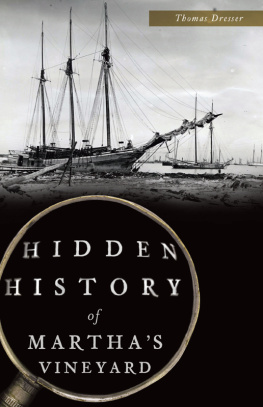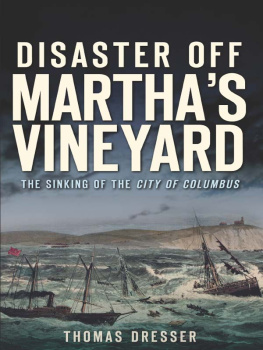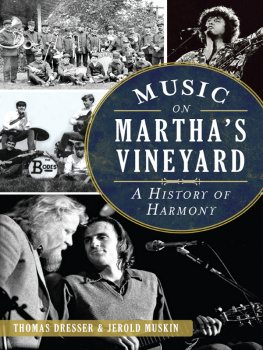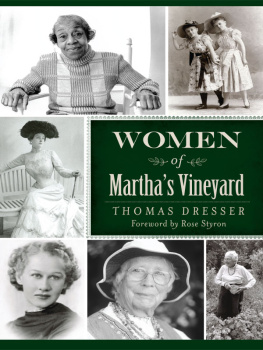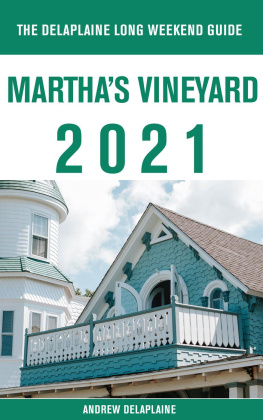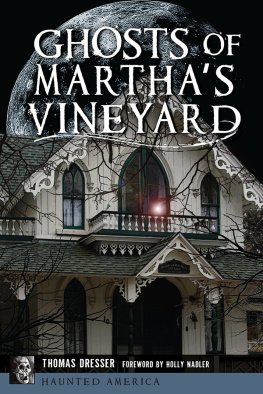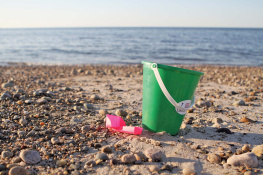


Published by The History Press
Charleston, SC 29403
www.historypress.net
Copyright 2010 by Thomas Dresser
All rights reserved
Front cover: top: Reverend Oscar Denniston and family, courtesy of the Marthas Vineyard Museum
and Doris Clark; bottom: Gay Head cliffs, photo by Joyce Dresser.
Back cover: top: Birthday party at the home of Dorothy West, courtesy of Olive Bowles Tomlinson;
bottom: The president and family at the Gay Head lighthouse, courtesy of Tom Wallace,
Wallace & Co., Sothebys International Realty.
First published 2010
Second printing 2010
e-book edition 2011
ISBN 978.1.61423.053.3
Library of Congress Cataloging-in-Publication Data
Dresser, Tom.
African Americans of Marthas Vineyard : from enslavement to presidential visit /
Thomas Dresser.
p. cm.
Includes bibliographical references.
print edition: ISBN 978-1-59629-069-3
1. African Americans--Massachusetts--Marthas Vineyard--History. 2. African Americans
-Massachusetts--Marthas Vineyard--Biography. 3. Marthas Vineyard (Mass.)--Race
relations. 4. Marthas Vineyard (Mass.)--History. 5. Marthas Vineyard (Mass.)--Biography.
I. Title.
F72.M5D74 2010
305.89607304494--dc22
2010019893
Notice: The information in this book is true and complete to the best of our knowledge. It is offered without guarantee on the part of the author or The History Press. The author and The History Press disclaim all liability in connection with the use of this book.
All rights reserved. No part of this book may be reproduced or transmitted in any form whatsoever without prior written permission from the publisher except in the case of brief quotations embodied in critical articles and reviews.
To my grandchildren
Besides time with my wife Joyceand writingmy favorite time is spent with
my grandchildren: Shealyn, Molly and Dylan.
CONTENTS
PREFACE
When President Obama vacationed on the Vineyard in late summer 2009, he added another chapter to the African American experience on Marthas Vineyard. The saga from slavery to emancipation to reconstruction and on through civil rights has been a tortuous struggle, embedded in our national conscience. That the first African American president chose to visit Marthas Vineyard is worthy of inclusion in the heritage of the Vineyard. It was his visit that initiated my intent to write this book.
One may ask what right or experience does a white man have to author a book about African Americans. Good point. I offer an objective account, one step removed, but able to present a perspective that encompasses the story through a wider lens, capturing historical relevance but omitting anger or bias that may taint my tale.
This book is not a memoir. It is not a textbook, nor a litany of ills. Rather, I sought to recount historical events within the timeline of American history. I was daunted, at first, by the task of interviewing African Americans about their Vineyard experiences. However, the outpouring of support, as well as curiosity, has served me well. This book is a historical compendium of contributions to the Vineyard community by African Americans.
It was an exciting adventure to compile the accounts on these pages. As stories continue to emerge from the dusty archives of history, they breathe life into this document. It was a privilege to report my findings.
PROLOGUE
The experience of African Americans on Marthas Vineyard has proven to be a seemingly endless struggle, a saga of events not that different from episodes in other parts of the country, but unique because of the Island setting and the resort community that evolved on the Vineyard.
The early history of African Americansenslaved by colonists to work the land, care for the house and rear their childrenwas typical of many northern states prior to the American Revolution. Life for African Americans across the country changed a great deal in the nineteenth century, with the Civil War and three key amendments to the Constitution. Yet segregation and subtle forms of racism persisted well into the twentieth century and beyond. And today, the issue of class distinction is a more relevant concern. For the African American population, the Vineyard was as challenging a place to live as anywhere.
As a unique resort community that attracted upper-class African Americans, the Vineyard began to define its own environment, typified by two leaders who arrived on the Island about 1900. Since then, vacationers have visited the Vineyard, first from Boston, then from New York and now from all over. The Vineyard truly has evolved into a haven for anyone seeking respite from the crush of humanity and the crunch of reality.
In July 1989, Ebony featured a spread on Marthas Vineyard and asked, What is it about this island that makes it a magnet for Black vacationers? According to Islanders, what Marthas Vineyard has, what Black folk flock to the island to absorb, and what they hope to take home is a little piece of their history, their glamour and their roots.
Jackie Hammond concluded her piece in the Intelligencer on African Americans, Bless all those hardworking, fun-loving souls who preceded us and thus made possible our days in the sun on Marthas Vineyard. Thats what this book is all about.
ACKNOWLEDGEMENTS
Whenever an author sits down to write, he becomes beholden to a host of associates, friends and unknown contacts who lend their advice and knowledge to his endeavor. They earn no financial reward, but achieve recognition by offering their contribution to the cause and perhaps feel a token of generosity for furthering a literary endeavor they endorse. Otherwise, they wouldnt help out.
A number of people offered their assistance:
Cynthia Meisner, librarian at the Vineyard Gazette, opened her file drawers with envelopes on myriad topics in my research. She was most generous with her time and assistance. And thanks to Eulalie Regan for assembling many of those envelopes.
The cast of the Marthas Vineyard Museum, from Dana Street to Linsey Lee to Susan Wilson, offered direction and focus in research of this project.
At the Oak Bluffs Library, former research director Mat Bose was more than willing to seek out that missing piece, which led to assemblage of the total puzzle.
The staff of the Vineyard Haven Library was very accommodating in my need to use the microfiche for ancient copies of the Vineyard Gazette, which proved much easier than scrambling through boxes of yellowed papers, as I did for Mystery on the Vineyard.
Mary Sicchio, of the Falmouth Historical Society, offered information on the antislavery movement, the background of Charles Bennett Ray and a pertinent piece on petitions.
Lee Blake, of the New Bedford Historical Society, steered me on board the Underground Railroad, even to the Vineyard, and traced the route of Frederick Douglass as he lectured across New England.
Paul Cyr of the New Bedford Public Library provided access to relevant census information.
Tom Wallace of Wallace & Co., Sothebys International Realty graciously allowed publication of his photo of President Obama at the Gay Head Light.
Chris Baer, who authored
Next page


